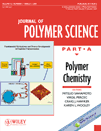Effect of the crosslink density on the morphology and properties of reaction-injection-molding poly(urethane urea) elastomers
Abstract
The effect of the crosslink density on the morphology and properties of reaction-injection-molding poly(urethane urea) (PUU) elastomers was investigated. Fourier transform infrared spectroscopy data showed that the linear and crosslinked PUU had entirely different hard-domain sizes and hard-segment ordering. A study of the morphology indicated that an increase in the crosslink density increased microphase mixing. Differential scanning calorimetry studies indicated that the hard-segment initial glass-transition temperature was independent of the crosslink density. The glass-transition temperature of the soft segment was highest when the network was perfect. The tensile-strength behavior showed that the mechanical properties of PUU reached a maximum when the network was perfect. The increase in the resilience of the crosslinked PUU elastomer was higher than that of the linear PUU elastomer with an increase in temperature, and the reduction of the hardness of the former was also higher than that of the latter. © 2004 Wiley Periodicals, Inc. J Polym Sci Part A: Polym Chem 42: 1126–1131, 2004




